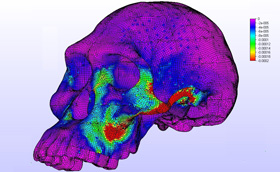
Release
National Science Foundation Funds UAlbany Research on the Evolution of the Human Skull
 Color mapping on this computer-generated, early human skull indicates levels of strain caused by bite and muscle forces. Bright red colors indicate areas of high strain caused by those forces, which are associated with chewing.
Color mapping on this computer-generated, early human skull indicates levels of strain caused by bite and muscle forces. Bright red colors indicate areas of high strain caused by those forces, which are associated with chewing. ALBANY, N.Y. (November 7, 2007) -- University at Albany anthropology professor David Strait has received a National Science Foundation grant of $940,000 to study how the facial skeletons of human ancestors and some primates are adapted to withstand the forces imposed by chewing. Strait's research will be part of the project, "Integrative Analysis of Hominid Feeding Biomechanics," which is a collaborative effort among researchers from nine other universities and colleges.
Strait's research will examine how the skull's shape has evolved in order to adapt to the forces associated with eating different types of food. He will focus on the skulls of the earliest human ancestors, which exhibit a collection of distinctive anatomical features in their jaws, faces and teeth. These features have long been thought to be adaptations to feeding on very hard or resistant food objects, including nuts and seeds, which may have been critical for survival during periods of scarcity.
"These dietary adaptations are thought to have been critical factors influencing the course of early human evolution, so this research project will provide valuable insights into the functional anatomy, diet, ecology and behavior of the earliest human ancestors," said Strait, who is the project director.
"We applaud David Strait's newest award from the National Science Foundation, which is a sign of the importance and stature of his research on evolutionary anthropology," said UAlbany Vice President for Research Lynn Videka.
Strait's research will examine the functional and evolutionary relationships between diet and skull form and collect data about skull biomechanics relevant to dentistry and craniofacial medicine. It will also generate data relevant to conservation efforts by documenting the relationship between ecology and adaptation in certain primates.
Researchers from The University of Chicago; Baylor College of Dentistry of Texas A&M; Arizona State University; George Washington University; Emory University; Mercer University; University of Massachusetts at Amherst; Kansas City University of Medicine and Biosciences; and the University of Vienna in Vienna, Austria, will also participate in the project.
The University at Albany's broad mission of excellence in undergraduate and graduate education, research and public service engages
more than 17,000 diverse students in 10 schools and colleges. For more information about this internationally ranked institution, visit the
University at Albany. Visit UAlbany's extensive roster of Faculty Experts.
Please send questions or comments about the UAlbany News site to: mediarelations@uamail.albany.edu